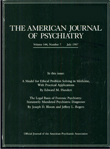HIV Seroprevalence Among Suicide Victims in New York City, 1991–1993
Abstract
OBJECTIVE: The authors sought to determine the HIV seroprevalence among suicide victims in New York City. METHOD: All suicides of city residents from 1991 through 1993 were studied. The crude proportion of all suicide victims who were HIV positive and the proportion adjusted to the age, gender, and racial/ethnic characteristics of the New York City population were determined. The demographically adjusted proportion was then contrasted with HIV seroprevalence estimates for the New York City general population. HIV-seropositive suicide victims were assessed for pathological findings suggestive of HIV-related illnesses. RESULTS: The crude proportion of all suicide victims who were HIV seropositive was 0.088, and the demographically adjusted proportion was 0.049. Over 90% of all HIV-positive suicide victims were aged 25 to 54 years, and almost 90% were men. Among black and Hispanic men aged 35 to 54 years who committed suicide, the proportion who were HIV seropositive was 0.252—the highest seropositive rate of any demographic group. More than two-thirds of HIV-seropositive suicide victims had no HIV-related pathology or AIDS-indicator conditions at autopsy. CONCLUSIONS: The demographically adjusted proportion of suicide victims who were HIV positive (approximately 0.038 to 0.059), contrasted with the HIV seroprevalence estimates for the New York City general population (approximately 0.014 to 0.032), the absence of HIV-related pathology among suicide victims, and the likelihood that many HIV-positive individuals had other risk factors for suicide, such as substance abuse, suggests that a positive HIV serostatus is associated, at most, with a modest elevation in suicide risk. (Am J Psychiatry 1997; 154:1720–1725)



